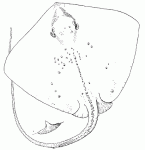There are three general ways fish in the sea give birth to a new generation.
 I will start off explaining what is most familiar to us, fish that give birth to live young. This is called being viviparous. There is a structure similar to the placenta that connects the embryo to the mother’s blood supply. Some shark species are viviparous. In fact, in some shark species such as the shortfin mako, the embryo has been known to eat other eggs developed by the mother.
I will start off explaining what is most familiar to us, fish that give birth to live young. This is called being viviparous. There is a structure similar to the placenta that connects the embryo to the mother’s blood supply. Some shark species are viviparous. In fact, in some shark species such as the shortfin mako, the embryo has been known to eat other eggs developed by the mother.
Next is something similar called giving birth oviviparously. This is when the embryo develops inside of an egg that is inside the mother. The difference between this and viviparity is that the embryo gets no nourishment from the mother. Nutrients are taken from within the egg. Coelacanths are a type of oviviparious fish.
Lastly, I will go over how 97% of fish species reproduce. These are the fish that lay many, many eggs and hide them in a dark corner so predators can’t get to them. This is called being oviparous. With most oviparous fish species fertilization takes place outside the body. But with many types of skates and rays (pictured right) the male will use his claspers to internally fertilize the female eggs before she lays them.
Image (c) www.gma.org







What people are saying …